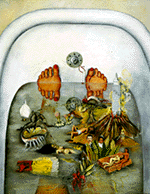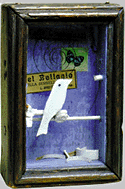|
The role of the private collector in the evolution of
Modern art has been immense. By providing crucial early
support and recognition to artists not yet widely known
or respected, and in having the freedom to collect
where institutions might be more cautious, private
enthusiasts have shaped tastes and dared to establish
trends. The Solomon R. Guggenheim Foundation was itself
built on the foresight of eminent collectors who
assembled bodies of work unparalleled in depth and
focus. In recognition of the centrality of the private
collection to the history of 20th-century art and to
the development of the Guggenheim Museum, Surrealism: Two Private Eyes, The
Nesuhi Ertegun and Daniel Filipacchi
Collections presents the most exceptional
grouping of Surrealist art in private hands today. The
exhibition outlines the visions of the two men and
brings together over 700 paintings, objects, works on
paper, photographs, books, bindings, and
ephemera--rarely seen works from collections that,
although developed in concert, have never been
presented together.
Sharing a
passion for jazz music and Surrealism, publisher Daniel
Filipacchi and the late record producer Nesuhi
Ertegun--sometimes independently, often side-by-side in
a friendly rivalry--built collections over the course
of almost four decades. They met in New York in June
1957, when Filipacchi was visiting from Paris to
conduct interviews for the Europe no. 1 radio network.
From his involvement in the jazz world, Filipacchi knew
of Nesuhi and his brother Ahmet; when Filipacchi and
Nesuhi met at a party for the Wilbur de Paris Orchestra
at the nightclub Jimmy Ryan's, they realized that music
was only one of the interests they had in common.
|
While
both men shared a love for Surrealist literature,
initially Filipacchi was more devoted to
Surrealist art than was Ertegun. Ertegun, who had
lived as a student in 1930s Paris and experienced
the Montparnasse café scene, was
originally drawn to Cubism and owned works by
such artists as Juan Gris and Fernand Lé
Filipacchi's enthusiasm for Surrealism was
infectious, however, and together the two men
visited artists such as Leonora Carrington,
Salvador Dalí, Max Ernst, Frida Kahlo,
Wolfgang Paalen, and Dorothea Tanning.
The two
collectors went on to acquire works by the most
important Paris-based Surrealists, such as Hans
Bellmer, Dalí, Ernst, René
Magritte, Joan Miró, Man Ray, and Yves
Tanguy. At the same time, they sought out the
work of prominent Surrealists from the rest of
Europe--such as Czech artists Jindrich Heisler,
Jindrich Styrsky, and Toyen--and from North and
South America, such as Kahlo, Kay Sage, and Kurt
Seligmann. They also purchased the work of
second-generation adherents to Surrealist
principles, such as Konrad Klapheck and Richard
Oelze, and other artists who shared a Surrealist
spirit, such as Joseph Cornell.
|
|

Frida Kahlo
What the Water Has Given Me
(Lo que el agua me dio), 1939.
Oil on canvas, 69 x 88 cm |

Joseph Cornell
Untitled (Hotel Bellagio),
ca. 1949-50.
Box construction,
17 x 11 x 5.5 cm.
©The Joseph and
Robert Cornell Foundation |
|
Surrealism
began not with the visual arts but as a literary
movement founded by French poet and writer
André Breton. When Breton defined the term
Surrealism in his 1924 Manifeste du
surré, the concept of Surrealist art
did not exist:
surrealism.
Noun,
masculine. Pure psychic automatism, by which
one intends to express verbally, in writing or
by any other method, the real functioning of
the mind. Dictation by thought, in the absence
of any control exercised by reason, and beyond
any aesthetic or moral
preoccupation.
Visual
artists were mentioned only in a footnote. This
absence began a debate among Breton's
followers--whether or not Surrealist painting
could transcend "aesthetic or moral
preoccupation"--that was not quieted until 1928,
when Breton wrote Le Surré et la
peinture. A painting that accepted the main
principles of automatism and dream imagery would
be considered Surrealist. Further, he advocated
that inspiration for art should be drawn from a
transformed reality or interior imagery rather
than what existed in plain view: "I find it
impossible to think of a picture save as a
window, and my first concern about a window is to
find out what it looks out on . . . and there is
nothing I love so much as something which
stretches from me out of sight." Breton preferred
the "window" to reveal what could not be readily
observed, imagery derived from the psychic,
internal world rather than the exterior
one.
|
Like Surrealism
itself, the roots of the Filipacchi and Ertegun
collections are in books rather than in visual art.
Around age 10, Filipacchi made his first purchase of a
Surrealist work, a copy of Breton's Le Revolver
à cheveux blancs. Attracted to the curious
title, The Revolver with White Hair, Filipacchi
thought he was acquiring a crime novel rather than a
book of poetry. It was this work that introduced him to
Breton, Surrealist typography, and poetry comprised of
metaphors and free associations. Ertegun's passion for
Surrealist poetry, also predating his interest in art,
was unmistakable from his first meeting with
Filipacchi, when Nesuhi's recitation of "A Season in
Hell" by Arthur Rimbaud--whom the Surrealists saw as a
precursor--launched their friendship. Their
collections, and this exhibition, reflect their shared
reverence for the literary heritage of Surrealism, with
numerous examples of original art for book and journal
illustrations by artists such as Victor Brauner,
Wifredo Lam, and Man Ray, as well as first-edition
books, unique illustrated manuscripts, and book
bindings. Georges Hugnet's La Poupé 2
(binding ca. late 1930s) is exemplary of the art of
making fine covers for books, often inspired by the
contents.
| While the
Ertegun and Filipacchi collections grew according
to their personal tastes rather than as an
art-historical exercise, the results provide an
overview of the scope and impact of Surrealism. By
disrupting conscious thought and liberating the
workings of the subconscious, the Surrealists
created new demands on reality and explored
aesthetic possibilities that profoundly influenced
the course of 20th-century art. One Surrealist
precursor represented in the collections is Giorgio
de Chirico, whose mysterious landscapes juxtapose a
rational, classical world and the arcades of
dreams. Surrealist artists attempted to give
objective reality to Sigmund Freud's notions of
repressed desires, dreams, and the unconscious. As
the artists were free to find their own routes of
expression--whether they chose abstracted forms,
fantastic imagery, or disquieting depictions of
everyday life--the works in this exhibition are
diverse in both style and approach. Also featured
in the Ertegun and Filipacchi collections are the
games and experimental techniques pioneered by the
Surrealists, such as automatism, cadavre
exquis, decalcomania, frottage, fumage,
grattage, and souflage. |
|

Giorgio de
Chirico
The Purity of a Dream (La Pureté
d'un rê've), 1915.
Oil on canvas, 65 x 50 cm.
©Foundation Giorgio de Chircio/Licensed by
VAGA, New York, NY |
Some artists,
such as Miró or André Masson, were drawn
to the method of automatism in which biomorphic shapes
arise from a web of lines laid down spontaneously, with
no composition or subject in mind. Ernst developed the
technique of frottage (rubbing) by transferring the
texture and grain of wooden floorboards to paper. The
random patterns that arose were transformed in Ernst's
hands into fantastic animals and mystic forests, as in
panels of Flute of the Angels (Vox
Angelica, 1943). Other artists, such as Magritte,
preferred the unsettling effects that arise from
unexpected juxtapositions of dissociated elements. His
poetic images established relationships between
incongruous objects--as in Memory (1954)--and
found visual analogues for literary ideas such as irony
and black humor. Dalí's paranoiac dreamscapes
draw on hidden content and latent meaning to create a
landscape of the unconscious.
As a means of
exploring the metaphors that arise from accidental and
chance combinations, the Surrealists experimented with
a parlor game in which participants jointly created a
phrase by each person's adding words to a piece of
paper without looking at what had previously been
written. One sentence created in this manner--"The
exquisite corpse will drink the young wine"--gave the
game its name, exquisite corpse (in French, cadavre
exquis). The game was quickly adapted to the
visual. Collective works made by folding a sheet of
paper, creating a section of a drawing or collage,
concealing the contribution, and passing it to the next
person resulted in works such as Untitled (1934)
by Tanguy, Brauner, and Jacques Herold, which are
visual equivalents of free association.
It is fitting
that the collections of Ertegun and Filipacchi are
united for the first time at the Guggenheim Museum.
Like the history of the Surrealist movement, the
friendship of the two men stretched from Filipacchi's
Paris to Ertegun's New York. By 1942, New York was the
world center of Surrealist activity, as exiled artists
sought to recreate the community they left in Paris.
Peggy Guggenheim's gallery, Art of this Century, was an
important point of contact. Continuing the involvement
she had established with the group during the 1920s and
'30s in Paris and London, Guggenheim continued to
champion the work of these Europeans as she introduced
them to contemporary American painters and vice versa.
The Solomon R. Guggenheim Foundation's involvement with
Surrealism has been shaped by Peggy Guggenheim's direct
participation in it. With this exhibition of the
Ertegun and Filipacchi collections, the museum presents
Surrealism through the unique perspective of private
individuals engaging the movement with historical
distance. Their visions provide an overview of rare
depth and focus into one of the most powerful currents
in 20th-century art.
--Tracey
Bashkoff, Assistant Curator
This exhibition is made possible by the
generous support of the Lagardère
Group.
|



